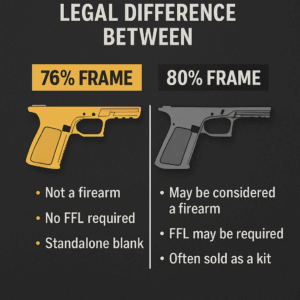🔧 What Are 80% Frames?
An 80% frame is a partially finished lower receiver (for handguns or rifles) that is not classified as a firearm under the Gun Control Act (GCA). Because it’s technically “unfinished,” it does not require:
- A background check
- An FFL (Federal Firearms License) for purchase
- A serial number (federally)
To be completed, an 80% frame typically requires drilling, milling, or other machining that transforms it into a fully functioning lower receiver.
However, in 2022, the ATF (Bureau of Alcohol, Tobacco, Firearms and Explosives) issued Final Rule 2021R-05F, tightening the definition of what constitutes a “frame or receiver.” This rule significantly reduced the legal gray area that 80% kits had previously occupied.
🛑 How ATF Final Rule 2021R-05F Changed the Game
The new rule redefined “firearms” to include frame blanks, jigs, templates, and related instructions when sold together. This means:
- Selling an 80% frame with a jig or instructions may now qualify as selling a firearm.
- Some previously unregulated 80% frame kits are now considered firearms and require serialization, FFL transfers, and background checks.
This crackdown pushed manufacturers and enthusiasts to seek alternatives that fall outside this expanded definition. Enter the 76% frame.
🔧 What Are 76% Frames?
A 76% frame is a firearm receiver that is less complete than an 80% frame — meaning more work is required to finish it, and fewer features are pre-machined. They are intentionally designed to avoid the ATF’s updated criteria that defines a frame as “readily convertible” into a working firearm.
Here’s what sets 76% frames apart:
- No pre-milled fire control cavity
- No indexing marks or tool paths
- No bundled jigs, tools, or instructions
- Often lacking rails or other structural components
- Sold as standalone blanks, not kits
Because they require significantly more effort, time, and skill to complete, the ATF currently does not classify 76% frames as firearms. This means they can be shipped directly to your door with no FFL and no background check.
⚖️ The Legal Difference: 76% vs 80%
| Feature | 80% Frame | 76% Frame |
|---|---|---|
| Considered a firearm by ATF? | Sometimes (post-2022 rules) | No (under current interpretation) |
| FFL required to purchase? | Possibly (depends on configuration) | No |
| Can be shipped directly to buyer? | Often not (when sold with jig/instr.) | Yes |
| Includes jig or tools? | Sometimes bundled | Never included |
| Fire control cavity partially done? | Yes | No |
| Requires serialization? | If considered a firearm | Not required under federal law |
Bottom line: The key legal difference is that 76% frames are intentionally designed to be “not readily convertible” and thus stay out of the ATF’s regulatory scope, while 80% frames are increasingly seen as crossing the line into “firearm” territory — especially when combined with jigs or instructions.
🧰 Why Builders Are Moving to 76% Frames
The appeal of 76% frames goes beyond just legal compliance. Builders are turning to them for:
1. Maximum Privacy
Because 76% frames do not require serialization or FFL transfer, they allow hobbyists to maintain privacy throughout the build process.
2. Challenge and Customization
Advanced builders enjoy the greater degree of fabrication required — giving them more control over the final result.
3. Future-Proofing Against Regulation
As laws and ATF interpretations continue to evolve, 76% frames offer a safer long-term investment for those wary of potential retroactive bans or legal gray areas.
⚠️ Legal Caveats and State Laws
While federal law currently allows the ownership and use of 76% frames, state and local laws may impose additional restrictions. For example:
- California requires serialization and may ban certain receiver blanks entirely.
- New York and New Jersey ban “ghost guns,” including unfinished receivers.
- Washington, DC prohibits possession of any unregistered firearm component.
Always check your state and local regulations before purchasing or building any firearm-related component.
📦 Can I Still Buy 80% Frames?
Yes — but with restrictions.
Some sellers offer 80% frames as standalone products (no jig, no instructions), but shipping is often restricted and may require a transfer through a licensed dealer. The ATF’s rules have made it riskier for both buyers and sellers.
By contrast, 76% frames are designed to sidestep these complications entirely — while still empowering enthusiasts to complete legal DIY builds.
🧠 Final Thoughts
The rise of the 76% frame is a direct response to changing legal realities. While 80% frames once offered a safe harbor for builders, recent ATF rulings have blurred the line between “unfinished” and “firearm.”
With a 76% frame, you’re working with a product that is:
- Not a firearm under federal law
- Shippable without an FFL
- Legal to purchase and own (in most states)
- A greater challenge — and greater freedom
Whether you’re a seasoned builder or a cautious first-timer, understanding the legal distinction between 76% and 80% frames is the first step toward building responsibly, legally, and independently.

